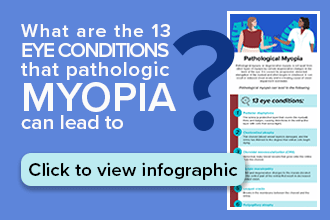Pathologic (degenerative) myopia: Definition, causes, symptoms and more

What is pathologic myopia?
Pathologic myopia, or degenerative myopia, is defined by certain degenerative changes in the back of the eye. It is caused by progressive, abnormal elongation of the eyeball. Pathologic myopia often begins in childhood and is a leading cause of visual impairment worldwide.
It is important not to confuse pathologic myopia with high myopia. High myopia is simply a high myopic refractive error. Pathologic myopia is the presence of degenerative changes to the back part of the eye. Having high myopia increases the risk for pathologic myopia, as they both result from progressive elongation of the eye.
When pathologic myopia occurs, it is typically in eyes with high myopia. However, it can also occur in eyes that do not have high myopia.
What causes pathologic myopia?
Pathologic myopia is largely due to abnormal growth of the axial length of the eyeball. The lengthening causes the retina and back of the eyeball to stretch. This results in thinning and degenerative changes to the retina, choroid and sclera. These changes can lead to permanent visual impairment and blindness.
Researchers are working to understand what causes myopia and why only some people with myopia develop this condition. Pathologic myopia is believed to be hereditary, so genetics likely play a role in its onset. Scientists are investigating which genes are responsible for myopia and whether they are the same ones as pathologic myopia.
According to the International Myopia Institute, while environmental factors are most likely driving common childhood myopia, extreme myopia likely is driven by different factors.
How common is pathologic myopia?
Pathologic myopia is one of the leading causes of blindness in the world. It affects up to 3% of the world’s population. As of 2020, more than 228 million people had been affected by vision loss due to pathologic myopia. In the United States, pathologic myopia is the seventh leading cause of legal blindness.
According to experts, as the prevalence of myopia increases around the world, the number of people with pathologic myopia will also likely increase. This is because the prevalence of pathologic myopia is higher in people with high myopia
Scientists expect that in 30 years, about 50% of the world’s population will have myopia. Of these people, 10% will have high myopia. This means that almost 4.76 billion people will have myopia by 2050. Nearly one billion people will have high myopia and an increased risk of vision loss.
What are common symptoms of pathologic myopia?
Pathologic myopia results in degenerative changes in the back of the eye. Symptoms caused by these structural changes may include:
Reduced visual acuity, even after correction
Blind spots in areas of central vision
Straight lines appearing wavy
Decreased contrast sensitivity
Difficulty with everyday tasks such as reading, driving or cooking due to distorted vision
Contact a doctor immediately if you notice a dark curtain over your vision or a sudden onset of floaters or flashing lights. These may be signs of a retinal detachment, which is an emergency condition.
How is pathologic myopia diagnosed?
An eye doctor will take a medical and family history. They will look at the back of the eye for structural changes caused by pathologic myopia.
They may perform imaging tests, such as:
Spectral domain optical coherence tomography to look for changes in the macula.
Fluorescein angiography to check for abnormal growth of new, leaky blood vessels.
How does pathologic myopia affect the eyes?
A posterior staphyloma is one of the main structural changes that occur in pathologic myopia. It happens when the sclera thins and bulges and causes distortions in the overlying retina.
Additional changes to the eyes associated with pathologic myopia include:
Myopic maculopathy – CNV and degenerative changes at the macula that result in decreased central vision
Peripapillary atrophy – Deterioration and thinning around the optic nerve
Chorioretinal atrophy – Retinal thinning to a degree that the cells begin dying
Choroidal neovascularization (CNV) – Abnormal, leaky blood vessels that grow onto the retina from the choroid
Lacquer cracks – Breaks in the membrane between the choroid (blood vessel layer) and retina
Fuchs spots – Scarring at the macula from CNV that causes missing spots in central vision
Changes associated with high myopia that may also be found in pathologic myopia include:
Retinal tears – A break in the retina
Retinal detachment – Retinal separation from the back of the eye
Glaucoma – A condition that can damage the optic nerve
Cataract – A clouding of the natural lens of the eye
Posterior vitreous detachment – Separation of the vitreous gel from the retina
Optic neuropathy – Damage to the optic nerve
People who have pathologic myopia or high myopia are at a higher risk of retinal detachment. They should consider avoiding contact sports and similar activities.
What is my risk for pathologic myopia?
The prevalence of pathologic myopia is higher in people with high myopia:
Low to moderate myopia (under -3.00 Diopters) – Prevalence is between 1% and 19%.
High myopia (over -6.00 D) – Prevalence is between 50% and 70%.
Researchers are investigating what genetic factors contribute to a person developing pathologic myopia.
Currently, we know that other risk factors include:
Higher myopic prescription
Greater axial length
Older age
According to the International Myopia Institute, the prevalence of pathologic myopia in children and adolescents is low. However, this prevalence increases with age and degree of myopia.
Children who develop pathologic myopia will have a higher risk of vision loss as they get older.
High myopes aged 40 and over have an increased prevalence and severity of changes to the back of the eye, such as myopic maculopathy.
The following conditions are also associated with an increased risk of pathologic myopia:
Down’s Syndrome
Ehlers-Danlos Syndrome
Marfan’s Syndrome
Low birth weight
Maternal alcoholism
SEE RELATED: Rare conditions associated with high myopia in children
How can I decrease my risk of pathologic myopia?
Pathologic myopia is a genetic disorder. Due to this, there is no definitive answer for how to decrease someone’s risk.
The risk of pathologic myopia increases with higher myopia. As a result, many researchers are investigating how to slow down the progression of myopia. Slowing progression could decrease the risk of pathologic myopia.
According to a recent publication in Updates on Myopia, 25% of those with high myopia may develop pathologic myopia. Half of those with pathologic myopia may develop visual impairment as older adults. The International Myopia Institute states that pathologic myopia affects 50%-70% of those with high myopia.
According to a 2019 study, if myopia is slowed by 1 diopter in childhood, the risk of pathologic myopia is lowered by 40%. This is significant for lowering the risk of visual impairment in later life.
Pathologic myopia generally begins in early childhood or the teenage years. Several strategies have been found to possibly slow down the progression of myopia in children, including:
Daily application of low-dose atropine eye drops
Myopia control eyeglasses and contact lenses
Overnight Orthokeratology
Environmental adjustments
Is pathologic myopia more common in some parts of the world?
Pathologic myopia is believed to be inherited. Since high myopia is associated with a higher risk of pathologic myopia, it is more common in populations with higher rates of myopia. It has a higher prevalence in Jewish, Japanese, Chinese and Middle Eastern communities.
In some East Asian countries, researchers have found that nearly four in five adults over age 18 have myopia. Approximately 1%-3% of Asians have pathologic myopia.
In Asian populations, the prevalence of visual impairment caused by pathologic myopia is 12%-27%. Because of this high rate, pathologic myopia is one of the leading causes of blindness in East Asia.
This trend has also occurred in the United States and Europe, although to a lesser degree. According to the American Optometric Association, myopia affects nearly one in three Americans. Researchers have found that 1% of Caucasians have pathologic myopia.
In Western populations, the prevalence of visual impairment caused by pathologic myopia is 7%.
Are there treatments for pathologic myopia?
Unfortunately, the length of the eye cannot be altered by medical or surgical treatment. The thinning of the retina, choroid and sclera is also irreversible. However, there are interventions available to help slow down or manage the condition.
Medical treatments
The use of optical coherence tomography (OCT) has allowed eye doctors to more easily identify structural changes caused by pathologic myopia, such as maculopathy.
Current interventions focus on minimizing the growth of new leaky blood vessels and preventing additional damage to the retina.
These interventions include:
Anti-VEGF therapy – An injection in the eye of a medicine that reduces the growth of abnormal blood vessels
Vitreoretinal surgery – A surgical procedure in the vitreous and retinal area of the eye
Photodynamic therapy – A procedure using a laser and a special medicine to seal off leaking, abnormal blood vessels
Posterior scleral reinforcement (PSR) – A surgical intervention to slow down axial elongation of the eye. Studies have found conflicting results for this procedure.
Optical correction options
High index lenses and smaller frames help to keep high-prescription glasses lighter and more attractive.
Contact lenses decrease visual distortions and improve peripheral vision.
Low vision aids
Low vision specialists are eye doctors who examine and manage the visual needs of people with decreased visual acuity. These doctors can provide devices and resources to help those affected by vision loss due to pathologic myopia.
IMI pathologic myopia. Investigative Ophthalmology & Visual Science. May 2021.
Global epidemiology of myopia. Updates on Myopia. October 2019.
Epidemiology and disease burden of pathologic myopia and myopic choroidal neovascularization: An evidence-based systematic review. American Journal of Ophthalmology. October 2013.
Chapter 62 - Choroidal neovascular membrane in degenerative myopia. Retina. Mosby. 2006.
Global prevalence of myopia and high myopia and temporal trends from 2000 through 2050. Ophthalmology. May 2016.
Pathologic myopia (myopic degeneration). American Academy of Ophthalmology. EyeWiki. March 2022.
Myopia and contrast sensitivity function. Current Eye Research. July 2009.
Posterior staphyloma in pathologic myopia. Progress in Retinal and Eye Research. 2019.
High myopia and its risks. Community Eye Health Journal. 2019.
Posterior vitreous detachment in highly myopic patients. Investigative Ophthalmology & Visual Science. April 2020.
High myopia and glaucoma-like optic neuropathy. Asia-Pacific Journal of Ophthalmology. June 2020.
Clinical findings and management of pathological myopic degeneration with secondary choroidal neovascular membrane macular hemorrhages. JOJ Ophthalmology. February 2018.
Myopia control: why each diopter matters. Optometry and Vision Science. June 2019.
IMI prevention of myopia and its progression. Investigative Ophthalmology & Visual Science. April 2021.
Myopia (nearsightedness). Cleveland Clinic Foundation. July 2020.
Global variations and time trends in the prevalence of childhood myopia, a systematic review and quantitative meta-analysis: implications for aetiology and early prevention. British Journal of Ophthalmology. July 2016.
Diagnosis and management of pathologic myopia. Retinal Physician. November 2019.
Myopia (nearsightedness). American Optometric Association. Accessed October 2021.
Global perspectives: Advances in diagnosis and treatment of pathologic myopia. Retina Today. August 2011.
Verteporfin photodynamic therapy in highly myopic subfoveal choroidal neovascularisation. British Journal of Ophthalmology. February 2003.
Posterior scleral reinforcement for the treatment of pathological myopia. International Journal of Ophthalmology. March 2016.
Page published on Wednesday, June 22, 2022







